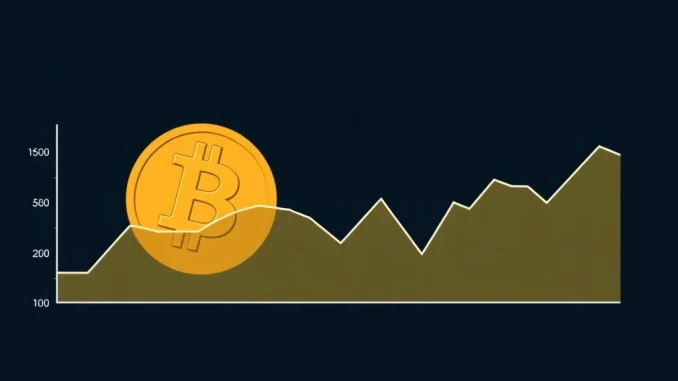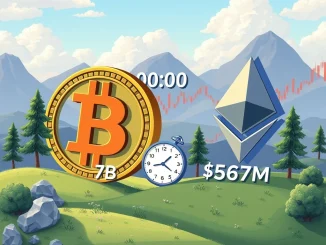
Are you finding the cryptocurrency market a bit… quiet lately? If so, you’re not alone. Bitcoin, the king of crypto, has been unusually still, and this period of low activity is grabbing the attention of analysts and traders alike. A recent report from crypto trading firm QCP Capital highlights just how significant this calm has become, noting that Bitcoin volatility has dropped to levels not seen in a year. But what does this mean for the market, and is it the calm before a storm, or simply a sign of deeper crypto market fatigue?
Understanding Bitcoin Volatility: What Does ‘Yearly Lows’ Mean?
Volatility is a measure of how much the price of an asset moves over time. High volatility means big, rapid price swings, while low volatility means prices are relatively stable and move within a narrow range. QCP Capital specifically points to implied volatility, which reflects market expectations of future price swings, continuing its decline.
Hitting ‘yearly lows’ for Bitcoin volatility suggests that, based on current market sentiment and trading patterns, participants aren’t expecting major price movements in the immediate future. The price action has been largely range-bound, bouncing between certain levels without a clear breakout or breakdown.
Historically, periods of exceptionally low volatility are often followed by periods of high volatility. The market tends to cycle between these states. However, the duration and trigger for the next volatile phase are always uncertain.
Signs of Crypto Market Fatigue: Why Is Momentum Lacking?
The report from QCP Capital uses the term ‘fatigue’ to describe the current state of the crypto market. This isn’t just about low volatility; it’s about a broader lack of directional conviction among market participants.
Several factors contribute to this fatigue:
- No Clear Catalysts: There aren’t any major, imminent events widely expected to significantly boost or tank prices. Regulatory news, technological developments, or major adoption announcements that could typically drive momentum have been sparse or have failed to generate sustained interest.
- Macroeconomic Inertia: Despite ongoing global economic developments, recent macro events haven’t translated into significant momentum for Bitcoin or the broader crypto space. This suggests the market is currently less reactive to external financial news than it might have been in more bullish or bearish phases.
- Trader Indecision: As QCP Capital notes, traders are showing signs of indecision. This is reflected in their positioning, such as extending bullish bets further out in time (into September, in this case) rather than placing aggressive bets on near-term price appreciation.
This combination of low expected movement, lack of external triggers, and trader hesitation paints a picture of a market that’s paused, perhaps waiting for a new narrative or event to provide direction.
What QCP Capital’s Analysis Reveals
The insights from QCP Capital provide a concise summary of the current sentiment:
- Implied Volatility Decline: Continues its downward trend.
- Yearly Lows: Bitcoin’s implied volatility is at levels not seen in about a year.
- Range-Bound Price: Price action remains stuck within a defined horizontal channel.
- Historical Patterns: Suggest volatility could potentially drop further through July.
- Lack of Catalyst: No obvious factor is expected to disrupt the current calm soon.
- Market Fatigue: A general sense of weariness and lack of conviction prevails.
- Extended Bullish Bets: Traders are pushing their optimistic outlooks further out, specifically into September, indicating they don’t expect a major upward move imminently.
This analysis from the crypto trading firm underscores the extent of the current market’s inertia.
Bitcoin Price Prediction: How Does Low Volatility Impact Future Moves?
Predicting the exact timing and direction of the next major move is challenging, especially during periods of low Bitcoin price prediction uncertainty. However, historical trends offer some clues.
Low volatility often acts like a coiled spring. The longer the price remains compressed in a tight range, the more significant the eventual breakout can be. When volatility does return, it tends to do so quickly and forcefully.
The fact that traders are looking towards September suggests they might anticipate a catalyst around that time – perhaps related to potential regulatory decisions, broader economic shifts, or even a seasonal increase in activity often seen later in the year. However, this is speculation, and the market could just as easily remain range-bound for longer.
For those interested in Bitcoin price movements, this period is less about capturing quick swings and more about patiently observing and preparing for potential future volatility.
Crypto Trading Strategies During Calm Periods
How should traders approach a market characterized by low volatility and fatigue? This environment requires a different mindset compared to trending or highly volatile markets.
Here are a few considerations for crypto trading:
- Range Trading: Focus on buying near the bottom of the established price range and selling near the top. This requires discipline and tight stop-losses.
- Patience: This is not a market that rewards impatience. Avoid chasing small moves. Waiting for a clear breakout from the range is often a more prudent strategy for capturing larger trends.
- Focus on Other Assets: Low volatility in Bitcoin doesn’t necessarily mean low volatility everywhere. Some altcoins or other crypto sectors might still offer trading opportunities.
- Prepare for a Breakout: Use this quiet time to plan potential trades for when volatility returns. Identify key support and resistance levels, and determine entry and exit strategies for both bullish and bearish scenarios.
- Risk Management: Regardless of market conditions, sound risk management is crucial. Position sizing and stop-losses are essential tools.
The extended bullish bets into September mentioned by QCP Capital suggest a belief that the market might awaken later in Q3. Traders might consider how to position themselves if that scenario plays out, while also being prepared for the possibility that the fatigue could persist or that a move could happen sooner than expected.
Summary
Bitcoin’s implied volatility has reached yearly lows, according to QCP Capital, signaling a period of significant calm and crypto market fatigue. With price action stuck in a range and no clear catalysts on the horizon, traders are showing indecision, pushing their bullish expectations further out.
While historical patterns suggest low Bitcoin volatility might continue through July, these quiet periods often precede larger moves. For crypto trading, this environment calls for patience, potential range strategies, and preparation for the eventual return of volatility. The current state of the market isn’t necessarily bearish, but rather reflects a pause, with participants waiting for the next significant development to dictate the direction of Bitcoin price prediction and the broader crypto landscape.
Keep watching the key price levels and external factors, as the period of fatigue won’t last forever.




Be the first to comment